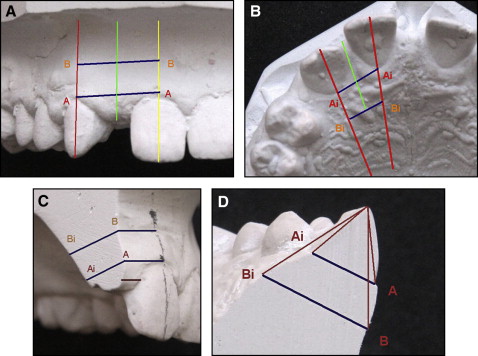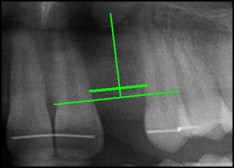Introduction
Orthodontic tooth movement can lead to the creation of bone. The purposes of the study were to investigate the amount of bone formed in orthodontic patients during treatment (maxillary canine distalization) and retention and to assess the long-term stability of the new bone.
Methods
The sample consisted of 80 patients with 128 missing lateral incisors who were treated with distalization of the maxillary canines. They were examined at the beginning of orthodontic treatment (T1), at the end of treatment (T2), 2 years after treatment (T3A), and 5 years after treatment (T3B). The influence of the canine’s inclination and its distance from the central incisor at T1 on the amount of bone created and the bone mass stability over time were assessed. Vestibular width of the alveolus was measured on casts at the level of the bone ridge and 5 mm apically from the alveolar ridge. Canine inclination to the alveolar ridge was recorded, as well as the height of the alveolar ridge.
Results
During treatment, T1 to T2, the alveolar ridge width was reduced by 4%, and the height decreased by 0.26 mm; during the retention periods (T2-T3A, T2-T3B), the alveolar ridge reduction was 2% on average, with individual variances, and height decreased by 0.38 mm on average. No correlation was found between canine inclination or between the canine distance from the central incisor at T1 and the amount and stability of the bone created by the orthodontic movement.
Conclusions
The bone created through orthodontic tooth movement was stable in both the horizontal and vertical directions. Changes in the width of the alveolus were not related to the amount of bone at the place of agenesis at T1. When the canine erupts next to the central incisor, favorable conditions affect the formation of the bone mass through distalization of the canine at the site of the missing lateral incisor.
Various treatment options are available for patients who are missing their maxillary lateral incisors. These include canine substitution, resin-bonded bridges, conventional fixed bridges, and implants. The choice of the treatment depends on certain relevant criteria. The ability to create the appropriate amount of space is an important factor. Orthodontic treatment plays a fundamental role, since it provides the required space through the appropriate tooth movement.
If a lateral incisor were extracted or avulsed, the buccolingual thickness of the alveolar ridge narrows by about 23% during the first 6 months. After 5 years, the ridge narrows an additional 11%, so the averall ridge shrinkage is about 34%. However, orthodontic tooth movement can lead to the creation of bone. As a tooth is moved orthodontically through the alveolus, remodeled bone forms behind the root, and this bone is retained along the width of the tooth that was moved. This principle is true even when the alveolus is narrow. Spear et al reported that, after space had been created for lateral incisors, the labiolingual alveolar dimension narrowed by less than 1% over 4 years. However, their sample size was small, and no other studies have corroborated their findings.
The purposes of our investigation were to determine the changes in the bone mass in the vertical and horizontal dimensions during orthodontic space opening, the changes in ridge dimension after a period of retention, and whether the canine inclination and its distance from the central incisor before treatment affect the amount and stability of bone created through distal movement of the maxillary canine.
Material and methods
The sample consisted of 80 patients with a total of 128 sites that were missing lateral incisors. These subjects were collected from the Department of Orthodontics at the Clinic of Dental Medicine in Olomouc, Czech Republic, and from 5 private orthodontic practices. In all subjects, space was opened for future prosthetic replacement of the lateral incisor. Maxillary dental casts of each subject were available at the beginning of orthodontic treatment (T1), at the end of active orthodontic treatment (T2), and after a period of retention (T3). The T3 time period was subdivided into 2 parts: 2 years after treatment (T3A) and 5 years after treatment (T3B). Panoramic radiographs were taken at T1, T2, T3A, and T3B. The ages of the subjects ranged from 11.2 to 31.2 years at T1, with a mean age of 18.06 years. The age range was 13.1 to 32.5 years at T2, with a mean of 19.8 years. At T3, the ages ranged from 16.2 to 34.9 years, with a mean of 23.83 years.
We used the following selection criteria: (1) all patients were missing at least 1 maxillary lateral incisor, and they had complete orthodontic treatment with fixed appliances; (2) the treatment involved canine distalization, with Angle Class I canine relationships achieved in all patients; (3) good quality panoramic radiographs were taken on the same device for each patient; (4) good quality dental casts were available at the appropriate times; and (5) the canines were not recontoured.
In 25 patients with unilateral agenesis, the opposite side was measured as the control group. We measured the width of the alveolar ridge at the site of the canine and the lateral incisor on the control side.
In the dental cast analysis, the distance between the canine and the central incisor was measured on the casts with a digital caliper at the level of the alveolar ridge at T1, T2, and T3. The sample was divided into 2 groups based on the distance between the canine and the central incisor at T1. The first group consisted of 77 sites with canine-to-central incisor distances up to 1.5 mm. The second group consisted of 50 sites with canine-to-central incisor distances greater than 1.5 mm.
The thickness of the alveolar ridge at the place of the missing maxillary lateral incisor was measured at Point A (level of the bony alveolar ridge 1 mm apically to a line connecting the cementoenamel junctions of adjacent teeth) and at Point B (5 mm apically to the alveolar ridge) ( Fig 1 ). The points measured on the dental casts were first determined with panoramic radiographs. The distance between the tip of the canine cusp and the canine alveolar ridge (at Point A) in the long axis of the tooth, and the distance between the tip of the canine and point B in the long axis of the tooth were measured on the panoramic radiograph at T1.

The same measurements were made for the central incisors. The long axes of the canine and the central incisor were traced on the dental casts at T1, T2, and T3 (the crown and alveolar ridge helped with the orientation). These values were traced on the dental casts made at T1, T2, and T3 from the both labial and palatal sides ( Fig 1 , A and B ). At the site of the missing lateral incisor, a line was established perpendicular to the occlusal plane. Then connecting lines were used to establish Points A and B on the vestibular side, and Ai and Bi on the palatal side ( Fig 1 , A and B ).
The dental casts made at T1, T2, and T3 were cut vertically in the middle of the alveolar ridge between the canine and the central incisor, perpendicular to the occlusal plane. In the sectioned dental casts, connecting lines A to Ai and B to Bi were established to depict the thickness of the alveolar ridge at 2 levels ( Fig 1 , C and D ). We measured and compared these distances during orthodontic treatment (T1-T2) and after treatment (T2-T3A and T2-T3B).
The level of the alveolar ridge at the site of the missing lateral incisor was measured at T1, T2, and T3. A line between the cementoenamel junctions of the adjacent teeth was established. A perpendicular line was extended from the middle of this line to the alveolar ridge and measured ( Fig 2 ).

We also measured the inclination of the canine to the alveolar ridge. It was defined as the angle between the axial aspect of the canine and the line running through the alveolar ridge ( Fig 3 ). The sample of patients was divided into 3 groups according to the angle between the canine and the alveolar ridge. The first group involved 43 sites with a canine inclination up to 90°at T1. The second group had 51 sites with a canine inclination between 90° and 100°at T1. The third group consisted of 33 sites with a canine inclination over 100° at T1.

The measurement error was established by randomly selecting 26 subjects. Their dental cast and radiographic measurements were repeated by the same person (S.N.) after 2 weeks. Statistical analysis of the differences between the first and second measurements was performed. To calculate the measurement error ( S x ), we used the Dahlberg’s formula,
Stay updated, free dental videos. Join our Telegram channel

VIDEdental - Online dental courses


